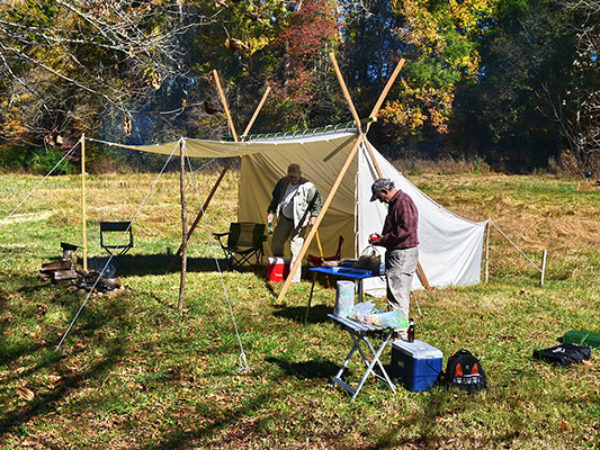REDISCOVER THE BAKER TENT
Base camp looked as inviting as a five star resort. We were fishing the headwaters of a Blue Ridge Mountains creek and each day we left the comfort of the tent camp to fight the tangles of brush to fish a little known rushing creek that offered fishing adventures few in today’s world know. At the end of each day of fishing we returned to our camp which consisted of a large baker-style tent located in a post card setting on a high hill overlooking the creek. The big white tent offered roomy sleeping comfort for two with room for gear storage. The front awning served as a protected area for cooking and simply lounging. Our campfire, the heart of the camp, was located just in front of the awning and it was there many fish were cooked; stories were told and on cool evenings a reflector fire was built to keep the interior of the tent warm. The camp would not have been the same with any other style tent; the almost forgotten baker tent was perfect for this trip, as it has been for countless other backcountry adventures.
The Name
If you want to start a heated campfire debate with a group of seasoned backcountry adventurers then offer an opinion as to when the first baker tent was used or where it got its name. I have seen shouting matches among friends that went on into the night when these subjects were debated.
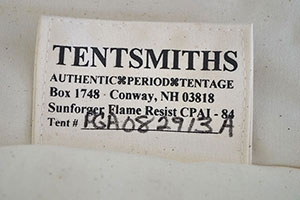 Baker Tentsmiths[/caption]First about the name and how it came about. According to my research, the name “baker tent” was most likely given to the tent sometime back in the 1800’s. Many logging and survey camps back in those early days used the “Yankee baker oven”, reflector oven as it is called today, to cook meals for hungry work crews and since the tents they used had the same profile soon the tents were called “baker tents”. The name stuck and today most still call this style tent the baker tent.
Baker Tentsmiths[/caption]First about the name and how it came about. According to my research, the name “baker tent” was most likely given to the tent sometime back in the 1800’s. Many logging and survey camps back in those early days used the “Yankee baker oven”, reflector oven as it is called today, to cook meals for hungry work crews and since the tents they used had the same profile soon the tents were called “baker tents”. The name stuck and today most still call this style tent the baker tent.
Not everyone agrees with this as there are writings that state that the name “baker tent” came from World War I, where cooks and bakers used a large lean-to style tent to prepare meals for the troops. It is said that the troops came to call the tents “baker tents” as it was where much of the baking was done. I could not find any verification of that.
However even today the modified lean-to style tent is not called baker tent by everyone. Some campers refer to it as the “campfire tent” because it is ideal for building a fire at its front to reflect warmth into the tents interior. The same fire can be a pleasure to sit by after a full day afield and the same fire is convenient for cooking. The late, well known, wilderness canoe adventurer and writer Bill Mason used and wrote about the tent in his excellent book Song of the Paddle calling it the “campfire tent”. Because of that the tent still has a following that calls it the “campfire tent”. Since Mason made some modifications to the basic baker tent design you can find some references to the tent as the “Mason tent”.
I have heard many campers, especially in the northeastern part of the U.S. refer to the tent as an “Adirondack tent” since it is shaped much like the Adirondack shelters made famous in such places as along the Appalachian trail and Baxter State Park in Maine.
I have been in a few Rocky Mountain camps that used the baker tent and they called it the “half-wall tent” as it looks like a traditional wall tent cut in half, long-ways, and using the other half as an awning. And if you go back to the mid 1800’s you will find one of America’s first outdoor writers calling the tent the “shanty tent”. So this interesting shelter has had many names but most professional campers agree that the name most people know the tent design by is the baker tent and most tentmakers call it that in their catalogs and promotions.
The History
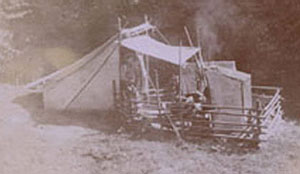 It is the history of the baker tent that causes the most debate. Mountain man re-enactors who like the tent design and want to use it during rendezvous cannot prove that it was a tent in use prior to the 1840’s, a requirement of many rendezvous groups. Other history buffs who are fans of the tent seek to discover when and where the unique tent began to be used. There is no conclusive history on the tent and its use. I have read that ancient drawings show tents of this profile being used by the early Romans about 100AD. It has been recorded that both English and French troops used a very similar design in the early 1700’s. I visited a fur trade museum a few years ago and the tour guide told me he did not know what the fuss with the mountain man rendezvous was all about that French explorers in the northern mid-west of the U.S. drew illustrations of the tents they used in the 1830’s that looked just like the baker tent.
It is the history of the baker tent that causes the most debate. Mountain man re-enactors who like the tent design and want to use it during rendezvous cannot prove that it was a tent in use prior to the 1840’s, a requirement of many rendezvous groups. Other history buffs who are fans of the tent seek to discover when and where the unique tent began to be used. There is no conclusive history on the tent and its use. I have read that ancient drawings show tents of this profile being used by the early Romans about 100AD. It has been recorded that both English and French troops used a very similar design in the early 1700’s. I visited a fur trade museum a few years ago and the tour guide told me he did not know what the fuss with the mountain man rendezvous was all about that French explorers in the northern mid-west of the U.S. drew illustrations of the tents they used in the 1830’s that looked just like the baker tent.
In more modern writings Henry David Thoreau wrote in his 1857 book The Maine Woods the description of a tent he used that was obviously a baker tent. In 1884 America’s first nationally known outdoor writer, George Washing Sears, writing under the pen name Nessmuk, wrote of a baker-style tent he used which he called a shanty-tent.
At the turn of the century between the end of the 1800’s and the beginning of the 1900’s another famous nationally known outdoor writer Horace Kephart lived alone in a tent camp often while exploring and writing about the Great Smoky Mountains. One of his favorite tents was the baker-style tent. The lean-to design turned the weather and the open front allowed for a reflector campfire to keep the camper warm. It was his tent of choice when he built his famous base camp, Camp Toco, on Dicks Creek in 1904.
My personal experience with a baker-style tent goes back to time back to my Boy Scout days in the late 1940’s and early 50’s when we used the official BSA baker tent for our summer camps. Some of my most fond memories are living most of the summer in the tents. They would go up in late May and stay up until early September. They were used hard for years without any major damage.
Throughout my outdoor career I have stayed in baker tents across North America and have enjoyed the experience each time. During one wildlife management project I lived in a remote location for 6 months in a baker tent and thought of it as home due to its comfort.
The Modern Baker Tent
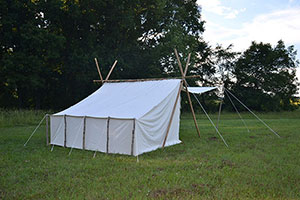 Today there are only a few tentmakers that offer a quality baker tent and last year when I decided it was time for me to return to a canvas baker tent for my exploration base camps I, after careful study, ask Tentsmiths of Conway, New Hampshire (www.tentsmiths.com) to make me an expedition-quality baker tent from the best tent making material, Sunforger-Flame finished 10.38 Army Duck Canvas. I chose Tentsmiths for several reasons. They are into their third decade of tent making. They have made thousands of tents, many for major movies and scientific expeditions. Their tents offer double sewn, flat-felled seams for strength. Sod flaps, sometimes called mud or snow flaps, are standard on all their tents. This 10-inch flap keeps the tent close to the ground and weather tight.
Today there are only a few tentmakers that offer a quality baker tent and last year when I decided it was time for me to return to a canvas baker tent for my exploration base camps I, after careful study, ask Tentsmiths of Conway, New Hampshire (www.tentsmiths.com) to make me an expedition-quality baker tent from the best tent making material, Sunforger-Flame finished 10.38 Army Duck Canvas. I chose Tentsmiths for several reasons. They are into their third decade of tent making. They have made thousands of tents, many for major movies and scientific expeditions. Their tents offer double sewn, flat-felled seams for strength. Sod flaps, sometimes called mud or snow flaps, are standard on all their tents. This 10-inch flap keeps the tent close to the ground and weather tight.
Knowing abrasion causes wear on canvas tents, Tentsmith’s reinforces a tent’s peaks, door overlaps, stake loop and eve areas because they are potential wear spots on a tent. There are no raw edges. When making a tent their craftsmen use the seams as a structural skeleton which, when combined with generous use of reinforcements, produces a structure able to withstand the worst of weather.
I was setting up a camp to do a photo shoot of the tent in use. We set up the baker tent and took a break to go get bar-b-q for lunch before placing all the camping gear and photo props. While we were gone, a sever thunderstorm blew in and a micro burst hit the tent. It was estimated by a hiker in the area at 60 – 70 MPH. When I got to the tent it was flat on the ground and the low spots of canvas were filled with water. I expected the worst. The tent pegs were bent, some made of 1/2-inch rebar. We dumped the water off it and gathered the tent up and carried it to a nearby barn to do damage control and to prepare to make repairs. Once we got it up where we could inspect seams, ties, peg loops, etc. we did not find any damage. The tent withstood the sudden fierce burst of wind and rain and held together with no sign of strain or damage.
This is the third, and most sever, storm the tent has endured and it still looks no worst for the wear.
Not Your Grandfather’s Canvas
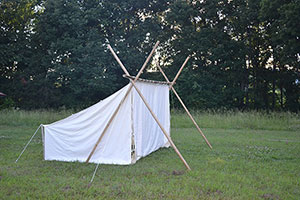 Today’s canvas is not the canvas that was on tents back in my Boy Scout days. For my baker tent I chose Sunforger-Flame finish canvas as it makes the tent water resistant, breathable, not water proof. It keeps the rain outside but allows the tent to breath and not sweat. Contrary to the old canvas tents of years ago, a Sunforger finished tent will not leak when touched from inside.
Today’s canvas is not the canvas that was on tents back in my Boy Scout days. For my baker tent I chose Sunforger-Flame finish canvas as it makes the tent water resistant, breathable, not water proof. It keeps the rain outside but allows the tent to breath and not sweat. Contrary to the old canvas tents of years ago, a Sunforger finished tent will not leak when touched from inside.
Sunforger-Flame has a flame resistant finish applied to the Sunforger treated canvas. That is about as close to flame proof as you can get with cotton duck material. Just because a tent has been finished with a flame resistant material does not preclude using good judgment when dealing with fires in camp. Since the baker tent is known best as a tent that is used most often with an open fire just beyond the front awning, care must be given to placement of the campfire and not to get it under the awning.
I ordered the baker tent to be made 8-feet, 6-inches deep, 11-feet, 3-inches wide, 7-feet tall at the front and 3-feet tall in the rear. I also ordered it with a flange in the ridge to give me versatility in putting the tent up. For extending covered space for cooking, sitting and gear storage the tent has an awning to extend the covered front of the tent 8-feet, 6-inches. Tentsmiths make the awning so that it can be lowered and tied to the front of the tent for privacy and security. I consider this size baker tent to be ideal for two people to camp in for long periods.
Poles, stakes, rope, etc. needed to erect the baker tent are also available from Tentsmiths but I wanted to make my own so they were omitted from the order. In many backcountry settings the poles can be cut on site but when I go to a camp location where I can get a vehicle near, I choose to haul my poles and leave as little sign as possible that I was there.
Care and Maintenance
A well-made baker tent if properly cared for should last many years even with hard use. Here are some guidelines to protect your investment:
- The major cause of most canvas tents having a short life is moisture and the resulting mold and mildew. Molds and mildew break down and weaken the fibers of the tent. A tent stored damp for just a short period of time will mildew and rot. Never store a tent that is not completely dry, which means you may have to set the tent up in the backyard after a trip and let the air and sun dry it completely before storing.
- Keep your tent clean. Dirt is an abrasive. If it gets embedded in the fibers of the canvas, it begins a slow process of wearing away at the structure of the tent from the inside. Never walk on your tent when setting it up or tearing down camp as this grinds in dirt and scuffs the fabric. I carry a soft bristle brush to brush dirt off my tent, especially when breaking camp and packing up.
- Ever the flame resistant finish on canvas does not mean burn-proof. Think about the wind direction when setting up your campfire in front of your baker tent. Keep the fire burning low and watch sparks and embers. Keep a bucket of water handy so that if a spark or ember should land on your tent it can be put out instantly.
- High wind and weight from snow or rain can place undue stress on rope loops and this stretches the fabric, especially around the loops. Keep your guy ropes and tent roof taut as this will prevent most problems of this type, if the tent is put up correctly. Make sure everyone in camp is aware of where of the guy ropes are so that no one trips over them and falls into the tent wall or roof. A 200 pound camper tripping over a guy rope at night while on the way to the latrine can throw a lot of weight on the lower part of the tent roof.
- Avoid using chemicals on or near your tent. Chemicals such as insect repellent or lantern fuel can do harm to the finish of your tent. Follow your tent manufacturer’s recommendations as to what, if any, cleaning chemicals to use on your tent. Most do not recommend the use of any.
Baker Tent Storage
- Perhaps more canvas tents are ruined due to improper storage than any other reason. By following these guidelines your tent can give you and your grandchildren many years of camping service:
- Upon returning home from a camping trip set the tent up in the backyard and allow it to dry completely.
- Clean it thoroughly. If it is really dirty you may want to hose it off, allow it to dry and then using a brush with soft bristles brush it off. Avoid any chemical cleaners or detergents unless recommended by the tent’s maker as this may ruin the tents finish.
- Once dry and clean, fold up without including any ropes, steaks or poles. Ropes are sometimes damp or have a chemical finish which can lead to canvas deterioration. The smallest amount of moisture can permit the growth of mildew on canvas. Stakes and poles can poke holes in canvas. Store the tent alone separate from the accessories.
- Store the tent in a cool dry area of your home out of direct sunlight. A hot storage shed or in the rafters of your garage can do damage to the tent.
- Do not store where mice can get to the material. They love to gnaw a hole into the canvas to make a nest.
Pros and Cons
Like any other tent the baker tent is not for everyone. To determine if one of these tents should be on your want list you need to consider the following pros and cons:
Pro:
- Open floor, roomy plan
- Comfortable for long stays in one location
- Well ventilated
- Warm in cold weather when used with reflector fire
- Ideal for use with cots
- The perfect tent for use with campfire
Con:
- Heavy, not for backpacking
- Requires long poles and lots of guy ropes
- Not good for insect season
- Not ideal for strong winds
- Takes time to set up and take down
As with most tents, the best way to determine if a baker tent is right for you is to find a friend who owns one or rent one and try it out. It will take a little time and experience to learn how to put it up. Use the tent on at least two camping trips. Then if you, like many of us who own and use the famous tent, do like it, then shop for the best you can find. It will give you many years of great camping with a little care.

